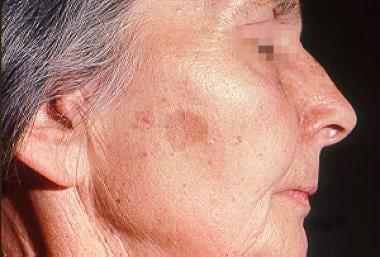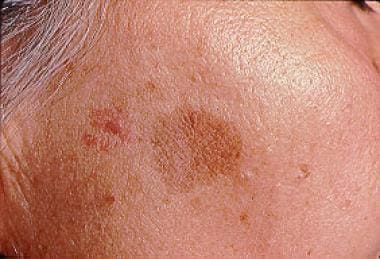Practice Essentials
A lentigo is a small, sharply circumscribed, pigmented macule surrounded by normal-appearing skin. Histologic findings may include hyperplasia of the epidermis and increased pigmentation of the basal layer. A variable number of melanocytes are present; these melanocytes may be increased in number, but they do not form nests. Lentigines may evolve slowly over years, or they may be eruptive and appear rather suddenly. Pigmentation may be homogeneous or variegated, with a color ranging from brown to black.
Multiple clinical and etiologic varieties exist. The distinction of a lentigo from other melanocytic lesions (eg, melanocytic nevi, melanoma) and its role as a marker for ultraviolet damage and systemic syndromes is of major significance.
A case-controlled study in France comparing 145 adults with multiple solar lentigines on the upper back and 145 matched control subjects found that multiple solar lentigines on the upper back and shoulders of adults may serve as clinical markers of past severe sunburn and may be used to identify a population at higher risk of developing cutaneous melanoma. [1]
The concept of “unstable solar lentigos” evident as irregularly pigmented macules on the background of chronic sun damage has been considered alongside the idea that they may have malignant potential. [2]
Note the images below.
Prognosis
Lentigines are benign by nature.
In patients in whom lentigines are associated with systemic abnormalities or complications, the prognosis may depend on the severity of the associated conditions.
Treatments with cryosurgery, lasers, and/or topical creams have been successful (see Treatment).
Patient education
Patients should be advised about the risks of sun exposure and the use of tanning beds.
Complications
Some lentigines have associated systemic manifestations that accompany the skin lesions (see Physical Examination).
Workup
Dermoscopic evaluation of a few lichenoid regressing solar lentigines showed a pattern similar to that of lichenoid regressing seborrheic keratosis. [3]
Preferentially expressed antigen in melanoma immunostaining may be utilized to distinguish early melanoma in situ from benign pigmented conditions. [4]
Also see Histologic Findings.
Treatment
See Treatment.
Pathophysiology
Long-term exposure to ultraviolet radiation and pollution as one ages may induce the common solar lentigo. [5] Depending on the type of lentigo present, a solitary lesion or multiple lesions can occur anywhere on the body. Some lentigines have associated systemic manifestations that accompany the skin lesions, such as the LEOPARD syndrome.
A Japanese microarray analysis evaluation of solar lentigo in 16 adults demonstrated up-regulation of genes related to inflammation, fatty-acid metabolism, and melanocytes and down-regulation of cornified envelope-related genes. [6] The researchers suggested solar lentigo may be induced by the mutagenic effect of repeated past UV light exposures, leading to characteristic enhancement of melanin production.
Little is known about the genetic basis of human solar lentigines, which were analyzed for potential FGFR3 and PIK3CA mutations. FGFR3 mutations were detected in 5 (17%) of 30 solar lentigines, and PIK3CA mutations were detected in 2 (7%) of 28 solar lentigines, suggesting that FGFR3 and PIK3CA mutations are involved in their pathogenesis and further substantiating previous speculations that ultraviolet (UV) exposure may be a causative factor for FGFR3 and PIK3CA mutations in human skin. [7] Lentigines, which develop earlier and are more pronounced in Japanese than in German women, have been found to correlate with variants in the SLC45A2 gene. [8] Extensive lentigo simplex, linear epidermolytic nevus, and epidermolytic nevus comedonicus were linked with a somatic mutation in KRT10. [9]
The LEOPARD syndrome may be associated with a mutation in the PTPN11 gene at Thr468Met. [10]
Etiology
The cause of lentigo formation depends on the type of lesion, as follows:
-
The cause of lentigo simplex is unknown. Case reports have described simple lentigines developing in children after use of topical tacrolimus for atopic dermatitis. [11]
-
Solar lentigo and ink-spot lentigo are associated with sun exposure in fair-skinned people.
-
Radiation lentigo is caused by local high-dose irradiation. [15]
-
Genetic factors may be involved in other forms of lentigines, including xeroderma pigmentosum (XP), LEOPARD syndrome, Peutz-Jeghers syndrome, and inherited patterned lentiginosis.
Epidemiology
Frequency
United States
In America, solar lentigines are observed in as many as 90% of whites older than 60 years and in 20% of whites younger than 35 years. Psoralen plus UVA (PUVA) lentigines are noted in almost one half of individuals with psoriasis who receive PUVA therapy for at least 5 years. They may also be evident in resolving psoriatic plaques in individuals, including children, who did not receive UV therapy. [16]
Lentigo simplex is the most common form of lentigo, but its frequency has yet to be determined. Alper and Holmes [17] noted multiple lentigines in 91 (18.5%) of 492 black newborns and 1 (0.04%) of 2682 white newborns; however, histologic confirmation of these lesions was lacking.
International
Lentigines are observed worldwide. The incidence depends on the type of lesion.
Seborrheic keratosis and lentigo solaris were found to be increased on the driver side of the face in an evaluation of truck drivers in Turkey assessing the effects of UV light. [18]
Race
Solar lentigines are more abundant in fair-skinned whites than in dark-skinned individuals, in whom the disease is distinctly uncommon because they have a greater amount of natural pigment that provides some degree of photoprotection. Lentigines, prominent skin signs of aging, develop earlier and are more pronounced in Japanese than in German women. [8]
Inherited patterned lentiginosis can occur in blacks, particularly those with mixed American Indian heritage and those with relatives with red hair. [19]
Ephelides, PUVA lentigines, tanning-bed lentigines, vulvar lentigines, ink-spot lentigines, [20] oral and labial melanotic macules, and Laugier-Hunziker syndrome are also more common in people with light skin than in those with dark skin. Ink-spot lentigo occurs in patients of Celtic ancestry.
Acral lentigines are more common in dark-skinned individuals, but they may also be present in light-skinned individuals.
Sex
PUVA lentigines are more common in men than in women. Tanning-bed lentigines and oral and labial melanotic macules are more common in women than in men.
Age
Lentigines can appear in both children and adults; however, children are more likely to have genetically associated lesions such as those of Peutz-Jeghers syndrome.
Adults are more likely to acquire lesions due to chronic exposures, which cause solar lentigo for example.
-
Thirteen-year-old Greek adolescent with xeroderma pigmentosum.
-
Ephelides (ie, freckles) on the forearm of a 26-year-old redheaded patient.
-
Woman with solar lentigo.
-
Close-up view of a woman with solar lentigo.











